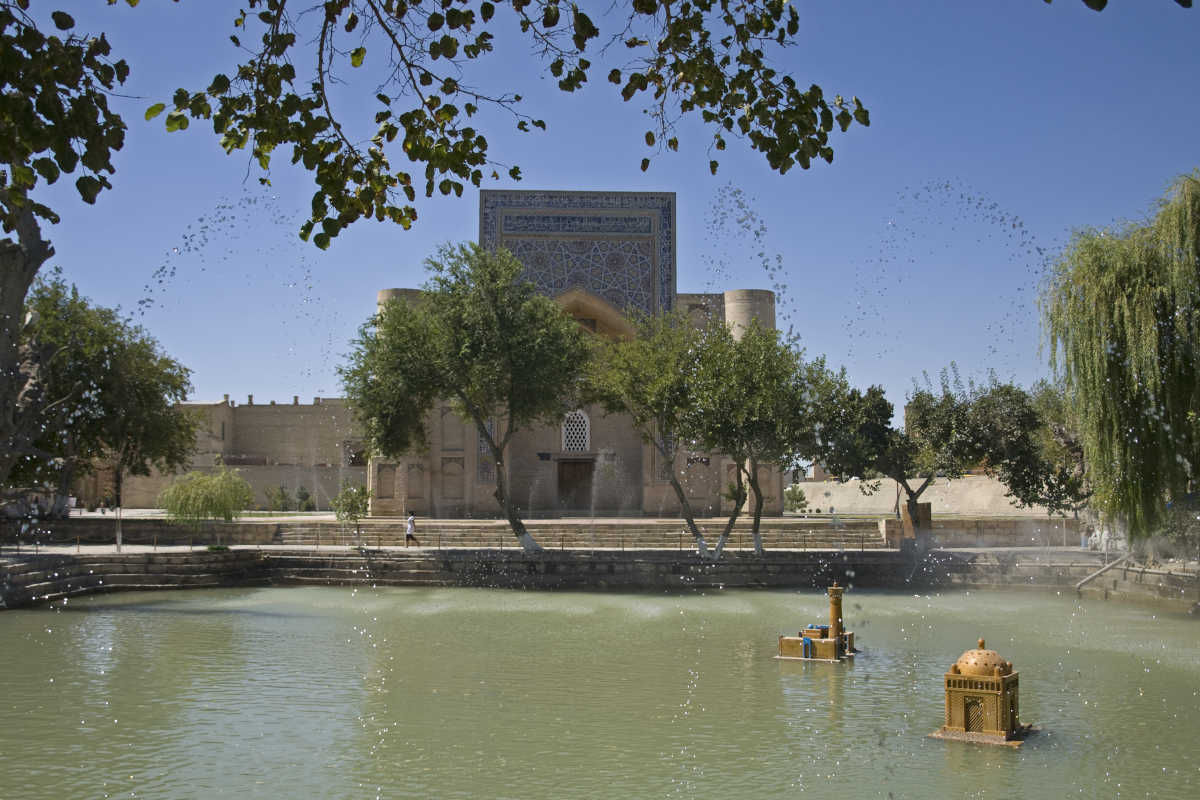Bukhara - Nodir Devon Begi Khanaka

Nodir Devon Begi Khanaqah in Bukhara: a masterpiece of Sufi architecture and spirituality
The Nodir Devon Begi Khanaqah in Bukhara is an impressive example of the architecture of the Central Asian Sufi orders and is an important architectural testimony to the religious and cultural heyday of this city. The building, which was constructed between 1619 and 1620 under the direction of Nodir Devon Begi, an influential statesman of the Ashtarhanid dynasty, still plays a central role in Bukhara’s spiritual and social life today.
Architecture and room layout
The Khanaqah, a multi-chamber building whose architectural centre is a spacious domed hall with a side length of 11.2 metres, impresses with its harmonious symmetry and functional design. The central hall, which was used for ritual gatherings and meditative meetings, is pierced on its sides by shallow niches, which not only give the room visual depth but also provide remarkable acoustics. This enabled the Sufis to experience prayers and chants in a special atmosphere of inwardness and resonance.
In the corners of the building are hujras – small living and meditation rooms that served as retreats for the dervishes. This intimacy of the architecture reflected the ideal of Sufism: the search for inner realisation and spiritual enlightenment in seclusion.
Historical context and spiritual significance
The Nodir Devon Begi Khanaqah was built at a time when the Sufi communities in Central Asia played an important social role. The Ashtarhanids and Shaibanids actively promoted these spiritual communities, which not only formed religious centres but also fulfilled social functions. Particularly noteworthy is the figure of Sheikh Khodja Hashim from Juibar, who died in 1636 and exerted great influence as a spiritual advisor to the ruling houses of Bukhara and Samarkand. He is said to have supported Imamkuli-khan (1611-1642) in consolidating his power in Bukhara.
The close connection between Nodir Devon Begi and Khodja Hashim is evident in the decision to build the Khanaqa in the immediate vicinity of the Magoki-Attari Mosque, a place of great religious significance. Presumably on the instructions of Khodja Hashim, the construction was initiated to offer the Sufis a place of contemplation, prayer and spiritual gathering.
The architectural ensemble of Nodir Devon Begi
The Khanaqah is an integral part of the larger architectural ensemble of Nodir Devon Begi, which also includes a madrasa and a caravanserai. This ensemble represents the close interweaving of religious and secular life in Bukhara. The madrasa, which is characterised by its magnificent façade and ornate tile work, served as an educational centre where aspiring scholars and Sufi novices were taught.
The location of the Khanaqah within the ensemble was by no means accidental: the combination of madrasah, Khanaqah and caravanserai emphasised the central role of Islam in daily life and created a place of encounter, exchange and spiritual contemplation.
The significance to this day
To this day, the Nodir Devon Begi Khanaqah attracts pilgrims and visitors from all over the world, who not only marvel at its architectural splendour, but also soak up the deep spiritual atmosphere of this place. The excellent acoustics of the large hall also make it a popular venue for traditional music performances and religious ceremonies.
The Khanaqah is symbolic of the cultural and religious diversity of Bukhara, a city that has functioned for centuries as an interface between East and West, as a centre of knowledge and spirituality. It is not only an architectural masterpiece, but also a living testimony to the spiritual currents that have characterised this region.
The Nodir Devon Begi Khanaqah in Bukhara is much more than a historical building – it is a symbol of the rich spiritual history of Central Asia. Its ornate architecture, deep roots in Sufism and outstanding acoustics make it a unique place that captivates pilgrims and architecture lovers alike. Amidst the vibrant cultural heritage of Bukhara, the Khanaqah remains a place of inspiration and contemplation whose significance extends to the present day.
